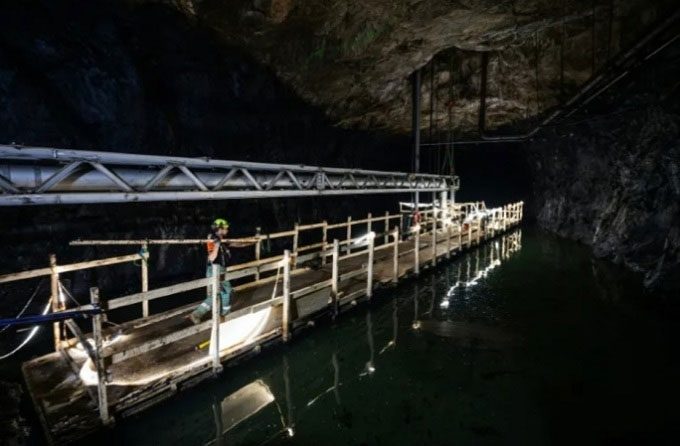Malarenergi is transforming a vast cave system spanning 300,000m3 into a hot water storage facility to provide heating for 130,000 residents.
Working lights hang along the rails illuminating the damp cave, where workers are preparing to convert an old oil storage facility into an “energy reservoir” for hot water to heat the town of Västerås, as reported by AFP on October 17. Excavated in the early 1970s, the three caves, with a total volume of 300,000m3, served as oil storage until they were abandoned in 1985. Now, the energy and heating company Malarenergi in Västerås is set to transform it into a hot water storage tank, according to project manager Rickard Svensson.

Inside the cave used for hot water storage by Malarenergi. (Photo: Jonathan Nackstrand)
The cave system is located near Malarenergi’s combined heat and power plant, which provides electricity and particularly warmth through a district heating system for approximately 130,000 residents of Västerås. Hundreds of meters of piping are being installed along with large heat exchangers so that excess heat can warm the stored water inside, which will then transfer heat when needed. In another area, workers are installing hundreds of steel bars to create a thick reinforced concrete wall that will serve as a “seal” for the cave.
Once the renovation is complete, the entire cave system will be filled with water and sealed. The area was previously cleaned of oil but has never been fully decontaminated. “It’s an extremely suitable place. While the plant can store heat in above-ground tanks, they are not located near the new installation area. The volume of the cave system is equivalent to 6,000 indoor swimming pools and can provide 13 gigawatt-hours (GWh) of energy,” according to Malarenergi.
The ability to store excess heat for future use means that management can reduce the operational demands of fossil fuel-dependent backup power plants during cold spells. Even for a few days, they can halt production and rely solely on the cave, utilizing the heat there, according to Malarenergi’s vice president Magnus Eriksson.
In a climate where temperatures can swing from -20 degrees Celsius in winter to over 30 degrees Celsius in summer, the underground heat reservoir can provide warmth for a week during cold days and about two weeks in summer. Although the idea of converting caves in this manner is not new, Malarenergi claims that their project is among the largest in the world.
The Finnish energy company Helen completed a similar project in 2021 on Mustikkamaa Island near Helsinki, with a storage capacity of 11.5 GWh of energy. A larger project by Vantaa Energy is also planned to be built north of Helsinki, with a volume of 1,000,000m3 and a capacity to store 90 GWh of thermal energy, utilizing superheated water.


















































